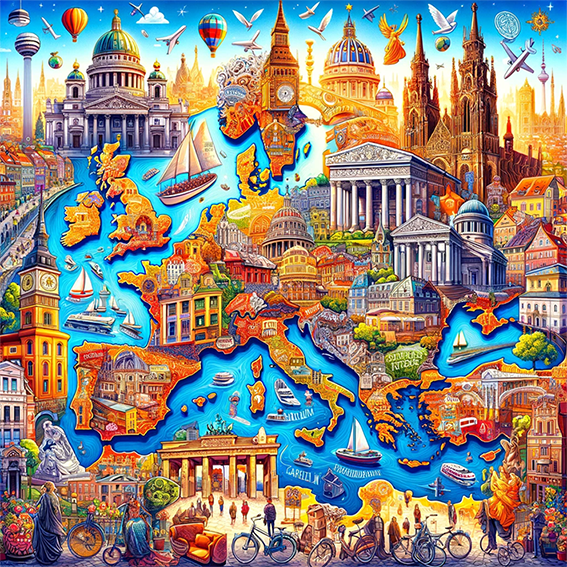Zollverein: Transforming an Industrial Icon into a Creative Powerhouse
- ARTISTIC HUB MAGAZINE

- Jun 22, 2024
- 4 min read
The Zollverein coal mine once stood as an industrial giant, a centerpiece of German power and innovation during the industrial revolution. When the last piece of coal was extracted in 1986, it seemed this magnificent structure would fade into obscurity. However, like a phoenix rising from the ashes, Zollverein underwent a spectacular transformation. From a monumental mining complex, it has evolved into a cultural and creative epicenter, becoming one of the most significant symbols of industrial revitalization and adaptation. Its story is one of transformation, innovation, and the human capacity to turn the unusable into the invaluable.

The Beginning of the Journey - The Rise of an Industrial Giant
Established in 1847, Zollverein extracted its first coal just four years later. Over the decades, the complex grew and developed, becoming one of the most productive mines in Europe. By 1932, with the opening of Shaft XII, Zollverein was a technical marvel, boasting a daily production capacity of 12,000 tons of pure coal, making it the largest mining facility in the world. Architects Fritz Schupp and Martin Kremmer designed this shaft in the Bauhaus style, making it an exemplar of modern industrial architecture.
In the 1960s, the addition of the coking plant further enhanced the complex's industrial significance. Throughout the following decades, Zollverein witnessed numerous industrial innovations, becoming a symbol of workforce strength and technological progress.
A New Beginning
In 1986, the mine was closed, and in 1993, the coking plant ceased operations as well. But instead of becoming just another abandoned industrial site, Zollverein found a new purpose. Shortly after its closure, restoration and conversion efforts began with the aim of creating an international center for culture and creativity.
The initial steps in this process focused on preserving the historical significance of the site while introducing new functions and features. In 1996, Casino Zollverein opened in the former compressor hall, and in 1997, Design Zentrum Nordrhein Westfalen moved into the renovated boiler house, creating the Red Dot Design Museum, which became a symbol of Zollverein's creative rebirth.
UNESCO Recognition and Further Development
In December 2001, Zollverein was designated a UNESCO World Heritage Site, a recognition that affirmed its exceptional universal value. This accolade not only ensured the preservation of the complex but also opened the door to further development of tourist and cultural offerings.
By 2010, Zollverein had become a symbol of the European Capital of Culture RUHR.2010, representing the transformation of the entire region from an industrial hub to a cultural center. Today, around 1.5 million visitors annually come to Zollverein to explore its rich history, enjoy cultural events, and admire artistic installations.
A Cultural and Creative Hub
One of the most significant transformations of Zollverein is its adaptation into a center for art and culture. Artists from around the world find inspiration in its unique industrial architecture and history. As visitors stroll through the complex, they encounter sculptures and installations created by artists such as Ulrich Rückriem and Alf Lechner. Their works not only embellish the space but also engage in an aesthetic dialogue with the surroundings, exploring themes of space and the site's transformation from industrial to artistic.
One of the most renowned artworks at Zollverein is the "Palace of Projects" by Ilya and Emilia Kabakov, housed in the former salt store. This installation presents 61 fictional projects aimed at improving human life in unusual ways, inviting visitors to dream and create.

Education and Sustainable Development
Zollverein is not only a cultural and artistic center but also a place for education and sustainable development. With its rich programs for children and young people, the complex offers opportunities to learn about industrial history, technology, and creativity. For example, the Children's Mining Circuit, with 14 different stations, allows children to learn about mining through play and interaction.
Moreover, Zollverein has become an important center for sustainable development, with projects focused on environmental preservation and the promotion of green technologies. These initiatives not only contribute to nature conservation but also educate visitors about the importance of sustainability.

The Future of Zollverein
Looking to the future, Zollverein continues to develop as a center for innovation and entrepreneurship. Aiming to become a model for structural change and transformation in Europe, the complex attracts new companies and startups, particularly in the creative industries. Plans for further development include opening new tourist and cultural facilities, such as museums, hotels, and restaurants.
One of the key projects is the renovation of the coke battery and the transformation of the "black side" of the plant into the new Denkmalpfad Kokerei (Coking Plant Monument Path), which will allow visitors to gain a deeper understanding of the site's industrial history.
Zollverein is a unique example of how industrial heritage can be transformed into a vibrant cultural and creative center. Through the combination of preserving historical legacy and introducing new, innovative elements, this complex has become a symbol of transformation and adaptation. Visitors from all over the world come to experience this unique synthesis of past and future, learning from Zollverein's story how the power of creativity and innovation can turn industrial ruins into symbols of hope and prosperity.
For more information about this fascinating place, visit their official website or follow their profile on Instagram.
Photos: © Sven Lorenzk, © Jochen Tack











